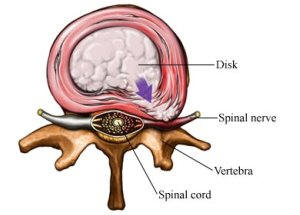The spinal disks are designed to cushion the vertebrae. They are made of soft spongy tissue with a liquid center (Nucleus Pulposus). The outer layer is called the Annulus Fibrosus and provides the structure of the disc. Theses disc do not have a blood supply but soak up nutrients and fluids from the surrounding area. Repeated trauma or misuse of the disks can cause this inter liquid to bugle out the surface of the disk.
Bulging disks are different from herniated disks in that bulging disk usually occurs gradually rather than all of a suddenly. A herniated disk is typically the result of an injury or overuse of the spine. Fortunately, most people who have bulging disk have no pain. In extreme cases when the disk actually breaks/herniates/ruptures the fluid will spill out of the disk and impinges on the nerves which is extremely painful. See photo –

When a nerve is impinged the body will fight back by starting an autoimmune response to the disc. This will bring severe inflammation and start to deteriorate of the nerve root. If not treated an individual can suffer permanent loss of sensory ability, mobility and strength.
As we age the outer portion of our spinal discs weaken. This makes it easier for pressure the central core to bugle the disk
Note: Many people have bulged disk and they aren’t even aware of it. Fortunately some people will never experience pain from it.
